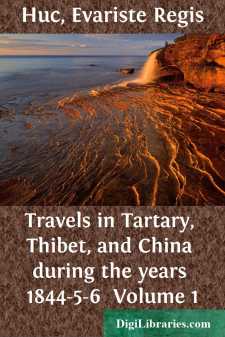Categories
- Antiques & Collectibles 13
- Architecture 36
- Art 48
- Bibles 22
- Biography & Autobiography 813
- Body, Mind & Spirit 142
- Business & Economics 28
- Children's Books 17
- Children's Fiction 14
- Computers 4
- Cooking 94
- Crafts & Hobbies 4
- Drama 346
- Education 46
- Family & Relationships 57
- Fiction 11829
- Games 19
- Gardening 17
- Health & Fitness 34
- History 1377
- House & Home 1
- Humor 147
- Juvenile Fiction 1873
- Juvenile Nonfiction 202
- Language Arts & Disciplines 88
- Law 16
- Literary Collections 686
- Literary Criticism 179
- Mathematics 13
- Medical 41
- Music 40
- Nature 179
- Non-Classifiable 1768
- Performing Arts 7
- Periodicals 1453
- Philosophy 64
- Photography 2
- Poetry 896
- Political Science 203
- Psychology 42
- Reference 154
- Religion 513
- Science 126
- Self-Help 84
- Social Science 81
- Sports & Recreation 34
- Study Aids 3
- Technology & Engineering 59
- Transportation 23
- Travel 463
- True Crime 29
Travels in Tartary, Thibet, and China during the years 1844-5-6 Volume 1
Description:
Excerpt
CHAPTER I.
French Mission of Peking—Glance at the Kingdom of Ouniot—Preparations for Departure—Tartar-Chinese Inn—Change of Costume—Portrait and Character of Samdadchiemba—Sain-Oula (the Good Mountain)—The Frosts on Sain-Oula, and its Robbers—First Encampment in the Desert—Great Imperial Forest—Buddhist monuments on the summit of the mountains—Topography of the Kingdom of Gechekten—Character of its Inhabitants—Tragical working of a Mine—Two Mongols desire to have their horoscope taken—Adventure of Samdadchiemba—Environs of the town of Tolon-Noor.
The French mission of Peking, once so flourishing under the early emperors of the Tartar-Mantchou dynasty, was almost extirpated by the constant persecutions of Kia-King, the fifth monarch of that dynasty, who ascended the throne in 1799. The missionaries were dispersed or put to death, and at that time Europe was herself too deeply agitated to enable her to send succour to this distant Christendom, which remained for a time abandoned. Accordingly, when the French Lazarists re-appeared at Peking, they found there scarce a vestige of the true faith. A great number of Christians, to avoid the persecutions of the Chinese authorities, had passed the Great Wall, and sought peace and liberty in the deserts of Tartary, where they lived dispersed upon small patches of land which the Mongols permitted them to cultivate. By dint of perseverance the missionaries collected together these dispersed Christians, placed themselves at their head, and hence superintended the mission of Peking, the immediate administration of which was in the hands of a few Chinese Lazarists. The French missionaries could not, with any prudence, have resumed their former position in the capital of the empire. Their presence would have compromised the prospects of the scarcely reviving mission.
In visiting the Chinese Christians of Mongolia, we more than once had occasion to make excursions into the Land of Grass, (Isao-Ti), as the uncultivated portions of Tartary are designated, and to take up our temporary abode beneath the tents of the Mongols. We were no sooner acquainted with this nomadic people, than we loved them, and our hearts were filled with a passionate desire to announce the gospel to them. Our whole leisure was therefore devoted to acquiring the Tartar dialects, and in 1842, the Holy See at length fulfilled our desires, by erecting Mongolia into an Apostolical Vicariat.
Towards the commencement of the year 1844, couriers arrived at Si-wang, a small Christian community, where the vicar apostolic of Mongolia had fixed his episcopal residence. Si-wang itself is a village, north of the Great Wall, one day’s journey from Suen-hoa-Fou. The prelate sent us instructions for an extended voyage we were to undertake for the purpose of studying the character and manners of the Tartars, and of ascertaining as nearly as possible the extent and limits of the Vicariat. This journey, then, which we had so long meditated, was now determined upon; and we sent a young Lama convert in search of some camels which we had put to pasture in the kingdom of Naiman. Pending his absence, we hastened the completion of several Mongol works, the translation of which had occupied us for a considerable time. Our little books of prayer and doctrine were ready, still our young Lama had not returned; but thinking he could not delay much longer, we quitted the valley of Black Waters (Hé-Chuy), and proceeded on to await his arrival at the Contiguous Defiles (Pié-lié-Keou) which seemed more favourable for the completion of our preparations. The days passed away in futile expectation; the coolness of the autumn was becoming somewhat biting, and we feared that we should have to begin our journey across the deserts of Tartary during the frosts of winter. We determined, therefore, to dispatch some one in quest of our camels and our Lama. A friendly catechist, a good walker and a man of expedition, proceeded on this mission. On the day fixed for that purpose he returned; his researches had been wholly without result. All he had ascertained at the place which he had visited was, that our Lama had started several days before with our camels. The surprise of our courier was extreme when he found that the Lama had not reached us before himself. “What!” exclaimed he, “are my legs quicker than a camel’s! They left Naiman before me, and here I am arrived before them! My spiritual fathers, have patience for another day. I’ll answer that both Lama and camels will be here in that time.” Several days, however, passed away, and we were still in the same position. We once more dispatched the courier in search of the Lama, enjoining him to proceed to the very place where the camels had been put to pasture, to examine things with his own eyes, and not to trust to any statement that other people might make....



